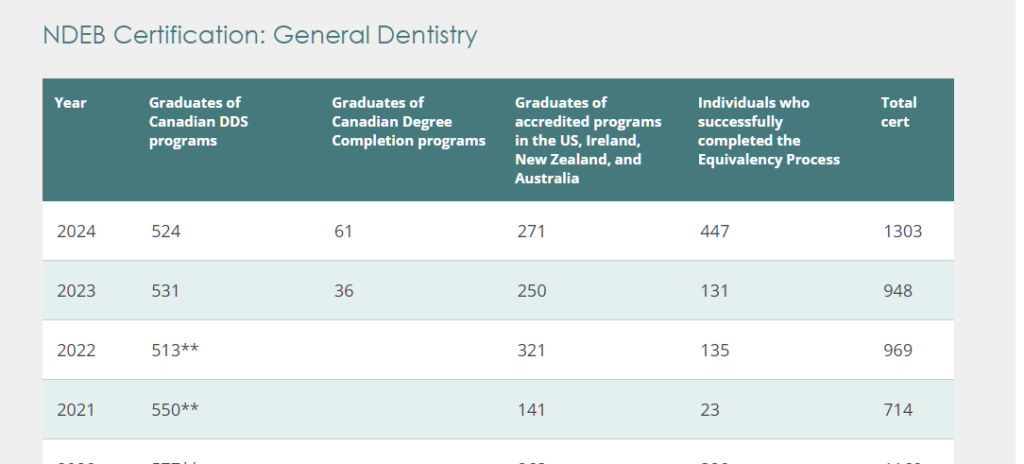Introduction
For internationally trained dentists (ITDs) seeking to practice in Canada, the pathway to licensure is a little harder and includes facing multiple challenges, involving a series of examinations and requirements set by the National Dental Examining Board of Canada (NDEB). A critical first component of this process is the Assessment of Fundamental Knowledge (AFK) examination, the first step in the NDEB Equivalency Process for graduates of non-accredited dental programs. Additionally, language proficiency, often demonstrated through tests like the International English Language Testing System (IELTS), plays a significant role in subsequent licensure steps. In this article, we will discuss the interplay between IELTS scores and subsequent steps where language proficiency matter, clarifies language proficiency requirements, and provide a complete guidance to the pathways for ITDs to obtain a dental license in Canada.

After credential evaluation, the first step towards getting a license is to pass the AFK exam. At this level, no language proficiency test is required .
The Role of the AFK in the NDEB Equivalency Process
The AFK is a 200-question multiple-choice examination that tests biomedical and applied clinical science knowledge, serving as the initial stepin the NDEB Equivalency Process. It is designed to ensure that candidates possess the foundational knowledge required to practice dentistry safely in Canada. The exam, which consists of two parts with 100 questions each, is offered in electronic form at Prometric centers or booklet formats and requires a standardized passing score of 75. Candidates have a maximum of three attempts to pass the AFK.
The AFK is not only required to enter to NDEB examinations, such as the Assessment of Clinical Judgement (ACJ) and the National Dental Examination of Clinical Competence (NDECC), but also a key requirement for admission to Canadian dental degree completion programs, such as the International Dentist Advanced Placement Program (IDAPP) at the University of Toronto or the International Dentist Degree Program (IDDP) at the University of Manitoba. Some DRAs ( Dental regulatory authorities ) provide bridge training programs , they also demand to pass AFK along with ACJ which is the second step in equivalency process .
Language Proficiency and the AFK Application
Language proficiency is a critical requirement for ITDs, as effective communication is essential for safe dental practice and interaction with patients, colleagues, and regulatory bodies. While the NDEB itself does not mandate a specific language proficiency test score for registering for the AFK, provincial Dental Regulatory Authorities (DRAs) and university programs often require proof of English or French proficiency for licensure or admission.
IELTS and Its Relevance
The IELTS Academic Module is one of the most widely accepted language proficiency tests for dental licensure and university applications in Canada. It assesses listening, reading, writing, and speaking skills, with scores reported on a 9-band scale. Many Canadian dental schools and DRAs specify minimum IELTS scores as part of their eligibility criteria. For example:
- University of Toronto IDAPP: Requires an IELTS Academic overall band score of 6.5, with not less then 6 in any of the .
- Royal College of Dental Surgeons of Ontario (RCDSO): Requires an IELTS Academic overall band score of 7.5, with minimum scores of 7.0 in each section (writing, speaking, listening, reading).
Get the latest updates on NDEB licence exams
While the NDEB does not require IELTS scores for AFK registration, candidates applying to university programs after passing the AFK must meet these language requirements. Additionally, DRAs may assess language proficiency informally through the candidate’s ability to complete written and clinical examinations, but formal english language proof (e.g., IELTS scores) is often required for final licensure.
Other Language Proficiency Tests
In addition to IELTS, other tests may be accepted depending on the institution or DRA:
- Certificate of Proficiency in English (COPE): Requires an overall score of 86, with 32 in writing and 22 in reading and listening.
- Test of English as a Foreign Language (TOEFL) iBT: Some programs accept a minimum score of 100.
- Academic Preparation ESL (University of Toronto): A grade of ‘B’ at the 60/Advanced level is accepted.
- Test d’évaluation de français (TEF) or Test de connaissance du français (TCF): For French proficiency in provinces like Quebec.
These test scores are valid for two years
When is language proficiency required ?
Language proficiency is required at several stages in the licensure process:
- Application to University Degree Completion Programs: Programs like IDAPP, IDDP, or the DDS Advanced Placement Program at the University of Alberta require proof of English proficiency as part of the application process, often before or after passing the AFK.
- Licensure by Provincial DRAs: After completing the NDEB Equivalency Process or a degree completion program, candidates must show language proficiency to obtain a license. For example, the RCDSO requires formal test scores or proof that the dental program was taught entirely in English or French.
- Clinical Examinations: Although english proficiency test are not mandatory , the ACJ, NDECC, and Virtual Objective Structured Clinical Examination (OSCE) assess communication skills indirectly through case scenarios, radiographic interpretations, and patient interactions.
The truth about IELTS scores and AFK applications
A common misconception among ITDs is that high IELTS scores are directly linked to AFK success or that they are a prerequisite for registering for the AFK. Here are some key truths:

- IELTS Not Required for AFK Registration: The NDEB does not mandate IELTS or other language proficiency test scores to register for the AFK. The AFK assesses the dental knowledge, it does not assess the English fluency.
- IELTS for University Applications: A passing score in AFK is crucial for admission to degree completion programs, but candidates must also meet the program’s language proficiency requirements. For example, a candidate with an AFK score of 90 may still be rejected from IDAPP if their IELTS score is below 6.5.
- Language Proficiency for Licensure: Even if a candidate passes the AFK and subsequent NDEB exams, DRAs may deny licensure if language proficiency is not demonstrated. This underscores the importance of preparing for language tests early in the process.
- Indirect Language Assessment: The AFK’s multiple-choice format does not directly test language skills, but candidates must understand complex scientific terminology and question structures. Poor English comprehension can hinder performance, making language preparation indirectly beneficial.
Steps in the NDEB Equivalency Process
The NDEB Equivalency Process is designed for ITDs whose dental degrees are not recognized by the Commission on Dental Accreditation of Canada (CDAC). The process consists of three main examinations, followed by certification exams:
- Credential Verification (10 weeks): Candidates submit academic credentials and supporting documents to the NDEB for verification. This step ensures the degree meets NDEB standards.
- Assessment of Fundamental Knowledge (AFK): A 200-question multiple-choice exam testing biomedical and clinical sciences. Maximum three attept are available to pass the exam.
- Assessment of Clinical Judgement (ACJ): An electronic exam evaluating diagnosis, clinical decision-making, and radiographic interpretation. Candidates must pass the AFK first and have three attempts to pass ACJ.
- National Dental Examination of Clinical Competence (NDECC): A clinical exam testing practical skills through 12 exercises on manikins. Candidates must pass the ACJ and have unlimited attempts, but all exercises must be passed.
- NDEB Certification Exams: After completing the Equivalency Process, the final step candidates take is the Written Examination and Virtual OSCE to obtain NDEB certification, which is required for licensure.
Pathways to licensure for internationally trained dentists
ITDs have two primary pathways to obtain a dental license in Canada: the NDEB Equivalency Process and degree completion programs. Below is a comprehensive guide to each pathway, including language proficiency requirements and other considerations.
Pathway 1: NDEB equivalency process
This pathway allows ITDs to achieve NDEB certification without returning to university, making it more cost-effective (approximately $35,000–$50,000) but challenging due to low pass rates. Calculate the approximate cost require to pass the equivalency process .
Steps:
- Credential Verification: Submit degrees, transcripts, and other documents to the NDEB. This takes about 10 weeks if documents are correct.
- Pass the AFK: Register through NDEBConnect and prepare the exam. After passing AFK , you can go to next step ACJ , of equivalency process or you can apply to university degree program if you want to choose this route .
- Pass the ACJ: Focuses on clinical judgment and radiographic interpretation. Preparation courses are recommended. Maximum three ettemts are available .
- Pass the NDECC: Conducted at the NDEB’s Ottawa facility, this exam tests clinical skills. Unlimited attempts are allowed, but all 12 exercises must be passed.
- Complete Certification Exams: Pass the Written Examination and Virtual OSCE to obtain NDEB certification.
- Apply for Licensure: Contact the provincial DRA (e.g., RCDSO for Ontario) and provide proof of language proficiency (e.g., IELTS 7.5 for RCDSO), NDEB certification, and other requirements like jurisprudence tests.
Language Proficiency Requirements:
- NDEB Exams: No formal language test required, but strong English comprehension is needed for exam success.
- Licensure: DRAs require formal proof (e.g., IELTS, TOEFL, or a letter confirming the dental program was taught in English/French).
Pros and Cons:

- Pros: Faster and less expensive than degree programs; no need to return to school.
- Cons: Low pass rates (45–50% for AFK, 85% overall success probability); requires significant self-study and preparation.
Pathway 2: Degree Completion Programs
These two- to three-year programs at accredited Canadian dental schools integrate ITDs into the Doctor of Dental Surgery (DDS) or Doctor of Dental Medicine (DMD) curriculum, typically starting in the second or third year. Graduates are eligible for NDEB certification exams.
Examples of Programs:
- University of Toronto IDAPP: Six-month preparatory program followed by entry into the third year of the DDS program. Requires AFK, Advanced Dental Admission Test (ADAT), and IELTS (6.5 overall, no band below 6.0).
- University of Manitoba IDDP: Two-year program starting in the third year. Requires AFK, ACJ, and ADAT (no longer accepts AFK alone for 2025 admissions). Language proficiency (e.g., IELTS) is required.
- University of Saskatchewan IDDP: Two-year program with a clinical skills assessment and interview. Requires ADAT and proof of English proficiency.
- University of Alberta DDS Advanced Placement: Three-year program requiring ADAT and English proficiency (e.g., IELTS or TOEFL).
Steps:
- Pass the AFK (and ACJ for some programs): AFK passing is often required. Some programs, like Manitoba’s IDDP Track B, require both AFK and ACJ within three years of application.
- Take the ADAT: Most programs now require the ADAT, which tests clinical and behavioral sciences, within three years of application.
- Meet Language Proficiency Requirements: Submit IELTS, TOEFL, or other test scores as specified by the program (e.g., IELTS 6.5 for Toronto, valid for two years).
- Apply to the Program: Submit applications with AFK/ADAT scores, transcripts, and a letter of intent. Some programs require interviews or clinical skills assessments.
- Complete the Program: Successfully complete the DDS/DMD curriculum, which includes clinical training and patient care.
- Take NDEB Certification Exams: Within three months of graduation, take the Written Examination and Virtual OSCE to obtain NDEB certification.
- Apply for Licensure: Submit NDEB certification, language proficiency proof, and other DRA requirements (e.g., CPR certification, criminal record check).
Language Proficiency Requirements:
- Program Admission: Formal test scores (e.g., IELTS, TOEFL) are mandatory and must be valid (taken within two years).
- Licensure: DRAs may require additional proof if not already submitted during program admission.
Pros and Cons:
- Pros: Structured education, clinical training, and higher likelihood of NDEB certification; integrates candidates into Canadian dental standards.
- Cons: Expensive (e.g., $100,000+ for tuition and fees); competitive admission; longer duration (2–3 years).
Pathway 3: Dental Specialty Assessment and Training Program (DSATP)
For ITDs seeking to practice as specialists (e.g., endodontists, orthodontists), the DSATP is an option after completing a specialty program from outside of Canada. Offered by some Canadian dental schools, it involves assessment and training (up to 12 months) to prepare for the National Dental Specialty Examination (NDSE) administered by the Royal College of Dentists of Canada (RCDC).
Steps:
- Credential Verification: Submit specialty credentials to the NDEB or dental school.
- Pass the Dental Specialty Core Knowledge Examination (DSCKE): Tests specialty-specific knowledge.
- Complete DSATP: Undergo assessment and training at a Canadian dental school.
- Pass the NDSE: Administered by the RCDC to obtain specialist certification.
- Apply for Licensure: Submit certification and language proficiency proof to the DRA.
Language Proficiency Requirements:
- Program Admission: Similar to degree programs, DSATP requires IELTS or equivalent scores.
- Licensure: DRAs require formal proof for specialist licensure.
Pros and Cons:
- Pros: Allows specialization; shorter than degree programs for specialists.
- Cons: Limited availability; highly competitive; requires prior specialty training from Country outside of Canada .
Comprehensive Guide for ITDs
To navigate the licensure process effectively, ITDs should follow these steps:
- Assess Eligibility:
- Confirm that your dental degree is from a non-accredited program (not recognized by CDAC) using the CDAC website.
- Ensure you have permanent residency or Canadian citizenship, as most programs and the Equivalency Process require this.
- Prepare for Language Proficiency:
- Take the IELTS Academic or another accepted test early, aiming for scores above the minimum (e.g., 7. 7.5 for RCDSO licensure).
- Keep scores valid (within two years) for university and DRA applications.
- Choose a Pathway:
- Decide between the NDEB Equivalency Process or a degree completion program based on cost, time, and career goals.
- For specialization, consider DSATP if you have prior specialty training.
- Prepare for the AFK:
- Give a proper time and plan accordingly to pass the AFK exam.
- Normally, most students take 6 to 9 months to prepare, but it varies from person to person, so plan accordingly
- Apply to Programs or Continue NDEB Exams:
- Submit applications with AFK, ADAT, and language proficiency scores for degree programs.
- Complete ACJ and NDECC for the Equivalency Process.
- Obtain NDEB Certification:
- Pass the Written Examination and Virtual OSCE after completing either pathway.
- Apply for Licensure:
- Contact the provincial DRA for specific requirements (e.g., RCDSO, Ordre des dentistes du Québec).
- Submit NDEB certification, language proficiency proof, CPR certification, and a criminal record check.
- Maintain Professional Standards:
- Stay updated on DRA regulations and continuing education requirements post-licensure.
Conclusion
The journey to becoming a licensed dentist in Canada for ITDs is complex, requiring dedication, preparation, and strategic planning. While IELTS scores are not directly required for AFK applications, they are critical for university admissions and licensure, making early language proficiency preparation essential. By understanding the NDEB Equivalency Process, degree completion programs, and specialty pathways, ITDs can choose the best route to achieve their professional goals. With proper guidance, resources, and perseverance, ITDs can successfully navigate this process and contribute to Canada’s dental profession.
References
- International Dentist Advanced Placement Program | Faculty of Dentistry, University of Toronto
- Assessment of Fundamental Knowledge (AFK) – The National Dental Examining Board of Canada
- DDS Advanced Placement | Mike Petryk School of Dentistry
- How to immigrate to Canada as an Internationally Educated Dentist
- Home – The National Dental Examining Board of Canada
- International Dentistry – Admissions | University of Saskatchewan
- The International Dentist Advanced Placement Program (IDAPP) | Faculty of Dentistry, University of Toronto
- AFK – Assessment of Fundamental Knowledge – Prepdoctors
- Practicing Dentistry in Canada Through CIDE
- International Dentist Degree Program (IDDP) | University of Manitoba
- NDEB Equivalency Process | A Brief Review of Revised Process
- How to become a dentist in Canada – The National Dental Examining Board of Canada
- Language Proficiency – Royal College of Dental Surgeons of Ontario
- Home – Royal College of Dental Surgeons of Ontario
- DentalPrep.ca – Assessment of Fundamental Knowledge


